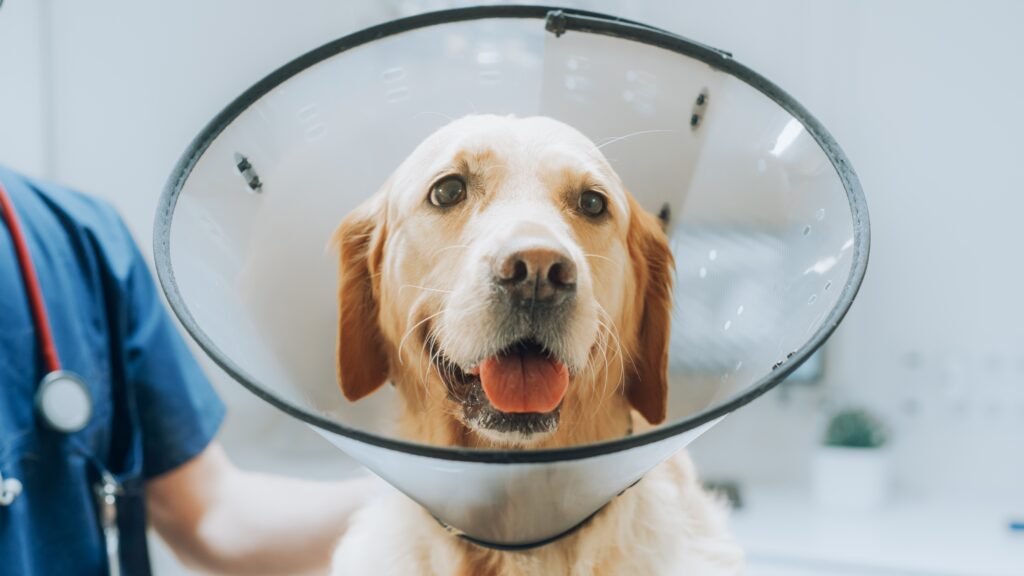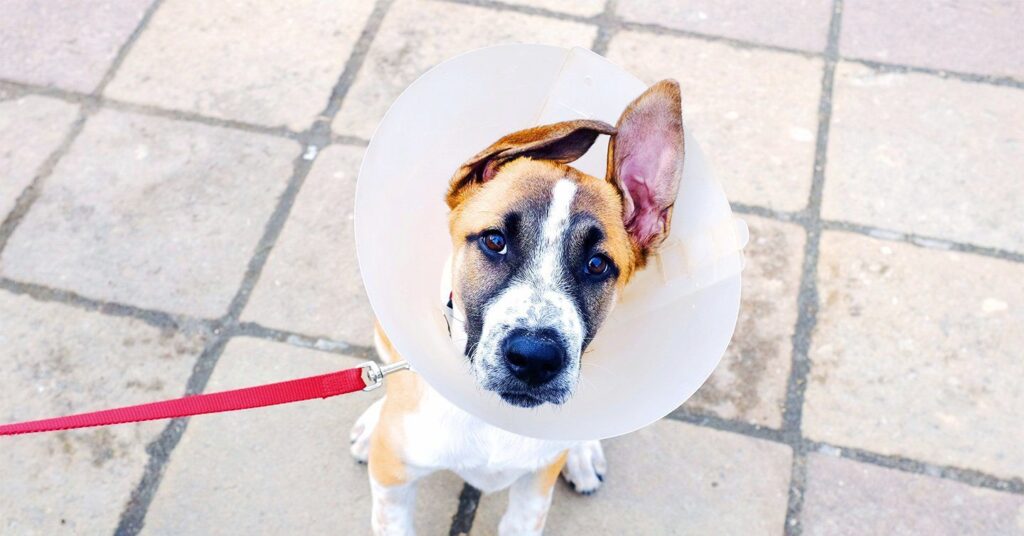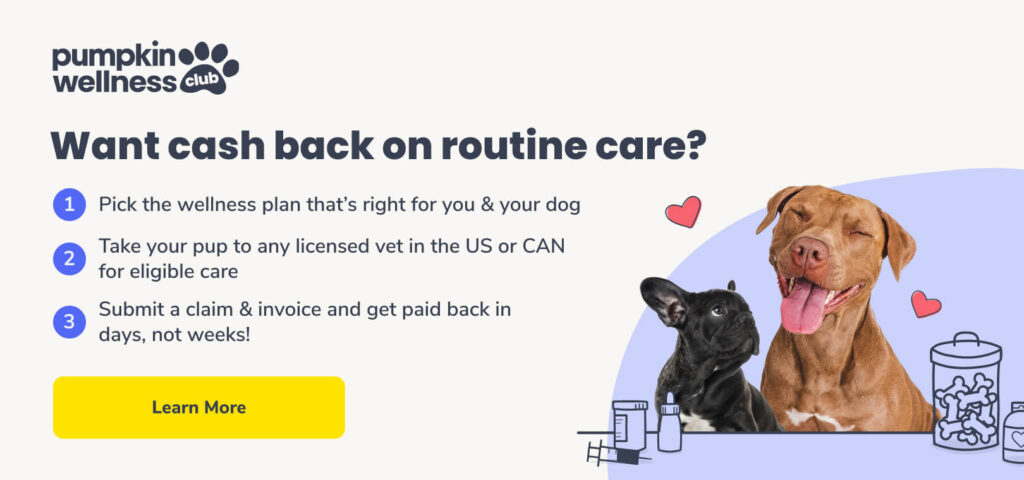- Anne Paglia
- Aug 26, 2024
- 7 min read
Updated: Oct 30, 2025
Key points
Spaying and neutering can benefit your dog’s long-term health and reduce pet overpopulation in shelters.
These surgical procedures can also help decrease unwanted behaviors like urine marking and roaming.
Veterinarians recommend spaying or neutering your dog when they’re 6 to 15 months old, depending on their breed.
Want to give your pup a shot (or should we say snip) at a happier, healthier life? Pumpkin Wellness Club* members have the option to get paid up to $150 for spay/neuter procedures, plus more cash for other routine preventive care services.
One of the biggest challenges of having a new puppy at home — aside from the pee pads and chew marks — is making sure they get all of the early veterinary care they need. A new puppy needs a list of core vaccinations, tests for worms, deworming, and typically a spay or neuter procedure.
While spaying and neutering are extremely common procedures for dogs and cats, there are still a number of misconceptions about them. New pet parents inevitably have questions about getting their dogs “fixed,” from when to do it to how much it costs. (Spoiler alert: If you’re looking to spend less on the cost of spay/neuter surgery and other preventive care services vets recommend, joining the Pumpkin Wellness Club is a great way to do just that.)
If you’re one of those pet parents, this article is for you. We’ll walk you through the benefits of spaying or neutering your dog, possible risks, and how to navigate recovery with a “cone of shame.” You might want to cover your pup’s ears for this one.
Benefits of spaying and neutering dogs

Spaying and neutering can lead to a number of health benefits for your pup, including a longer lifespan. In fact, the life expectancy of neutered male dogs is 13.8% longer than that of unneutered dogs, and the life expectancy of spayed female dogs is 26.3% longer than that of their unspayed counterparts. For many pet owners, those extra years are well worth the small hassle of the spaying or neutering procedure.
Why do neutered and spayed dogs live longer than those that aren’t? For one, they’re less likely to develop diseases affecting the reproductive system, like uterine infections and cancer, breast cancer, testicular cancer, and prostate issues. Some of these illnesses can be fatal; most take a severe toll on your pup’s well being. Eliminating the possibility or decreasing the risk that these problems will arise can help your dog live a longer, healthier life.
Pet Pro Tip: Join the Pumpkin Wellness Club, a new program that actually pays you for getting your pup the routine preventive care that they need to stay healthy. Members can save up to $360 per year on annual visits, vaccines, and more routine care, plus other perks like discounts on top pet brands.
Second, spaying and neutering your dog can reduce risky behaviors driven by sex hormones. Female dogs in heat and male dogs looking to mate are more inclined to roam, which can put them in harm’s way of traffic and predators. Likewise, unneutered male dogs are more likely to act aggressively, hump, urine mark, and fight with other pups, which can lead to injuries and infections.
Finally, another important reason to spay or neuter your dog is to play a part in preventing pet overpopulation and homelessness. Almost one million shelter animals are euthanized each year in the United States, according to the ASPCA. The best way to prevent animal shelter deaths is to reduce the number of pets giving birth in unsafe or accidental circumstances. Spaying or neutering your dog is a great way to do your part.
The best time to spay or neuter a dog
Now that you’re familiar with the reasons why dogs are spayed or neutered, you’re likely wondering about the best time to do it and if it’s too late for your pup. Of course, every dog has different needs and health circumstances, so it’s best to consult your vet regarding any medical procedure.
With that in mind, the American Animal Hospital Association recommends the following spay and neuter timelines for small and large dog breeds:
Small female dog breeds: Prior to the first heat, around 5 to 6 months of age
Small male dog breeds: 6 months of age
Large female dog breeds: 5 to 15 months of age
Large male dog breeds: After growth stops, around 9 to 15 months of age
Fully grown adult dogs can be spayed or neutered as well, but it’s best to consult your veterinarian before making any decisions. The procedures can bring more complications for dogs that are overweight or have existing health conditions, but overall can still be beneficial for healthy, adult dogs.
Common misconceptions about dog spaying and neutering

Roughly 78% of owned dogs are spayed or neutered, according to a 2021-2022 survey by the Humane Society. Still, many people are hesitant to sign their pets up for the procedure. A few common misconceptions may be to blame, such as:
Spaying and neutering causes weight gain. This is false. Your pet will gain weight if they overeat or under-exercise, regardless of their spay/neuter status.
Spaying and neutering causes bad behavior. Quite the opposite. While spaying or neutering won’t fix all of your dog’s bad habits, it’s been shown to decrease unwanted behavior like roaming, fighting, and mounting.
Purebred animals shouldn’t be spayed or neutered. Spaying and neutering isn’t just a form of birth control. The procedures also can decrease unwanted behaviors and lower your dog’s risk of long-term health issues.
If I can find homes for puppies, I don’t have to spay or neuter my dog. Even if you know people willing to take home puppies, it’s still a smart idea to spay or neuter your dog. There are already plenty of shelter animals in need of loving homes.
Spaying and neutering is expensive. While spay/neuter procedures can cost you up to $400, the Pumpkin Wellness Club can help you get up to $150 in cash back, depending on your membership option (more on that later).
Typical costs of spaying or neutering a dog
The cost of dog spaying and neutering can vary depending on where you’re getting the procedure done and your dog’s unique circumstances. Check with your vet about their pricing, and if it’s out of your price range, look for a low-cost spay and neuter clinic in your area.
According to Gallant, low-cost clinics can charge as little as $35 for spay/neuter services, while veterinary clinics will likely charge more (up to $400). However, you get what you pay for — some dogs develop kennel cough after having spay or neuter surgery done at a low-cost clinic, so make sure your dog is vaccinated well before the surgery.
The benefits of having your regular veterinarian spay or neuter your dog include:
More personalized and better service
Preoperative blood work to ensure your dog is safe for anesthesia
More comprehensive pain management both during and after the procedure
Better follow-up care
Lower risk of infectious disease compared to some low-cost clinics
Another way to get help with spay/neuter costs is to enroll in a wellness program or plan that pays you for your pet's preventive care. While pet insurance plans for accidents and illnesses don’t typically cover the costs of spaying or neutering a pet, the Pumpkin Wellness Club features a membership option that pays up to $150 towards the procedure. What’s more, you can also get cash for other important preventive care services, like vaccinations, annual checkups, and more — so even after your pup is ‘fixed,’ there are plenty more perks ahead.
Remember: the expense of medical conditions resulting from not spaying or neutering your dog (like cancer or uterine infections) will likely be much higher than the cost of a spay or neuter procedure. Treating pets with reproductive system cancers can cost thousands of dollars, and tending to injuries from fights or accidents can also take a toll on your wallet.
Tips for spay and neuter recovery
Once you’re ready to have your pooch spayed or neutered, contact your veterinarian. They’ll advise on the ideal timing for the procedure and walk you through what to expect.
In general, the surgery ranges from 30 minutes to an hour, or sometimes two hours in complicated surgeries. Afterward, your pet will need about two weeks to rest and heal. Your dog will likely be tired as they come out of anesthesia or off of pain medication. Let them rest in a quiet space away from other pets.
During the healing process, keep an eye on the incision for any redness, swelling, odor, or discharge. Dogs should also be prevented from licking the surgery site, as that can cause infection and complications. Most dogs will be discharged from the veterinary hospital or clinic with an Elizabethan collar (named for the English queen and fashion trend of the era) to prevent licking. Keep it on your pet at all times, or at least when they are unsupervised.
Don’t bathe your pup until the incision fully heals. It’s also very important for dogs to stay quiet and calm while they’re healing. If they are too active too soon, the incision may open up, which can be disastrous. If you have a wild child, ask your vet for a sedative to keep your dog quiet for healing.
Before you know it, your dog will be happily healed and ready to return to their regular routine
How to get started with spaying or neutering
If you’re bringing home a new fur family member, make sure you find a veterinarian who can set your dog up for a happy and healthy life. Reading this article is a great start, but a licensed vet will be more qualified to answer any specific questions about your pet's needs.
DISCLOSURE
*The Pumpkin Wellness Club offers two different membership options, including our Premium plan which offers members up to $150/yr toward a spay/neuter procedure OR routine dental cleanings. Pumpkin Wellness Club is marketed and administered by Sprout Wellness Services LLC (d/b/a "Pumpkin Wellness Club"). Pumpkin Wellness Club is not an insurance policy. It is offered as a standalone pet wellness membership program. For full terms, visit pumpkinwellness.com/membership-agreement.




